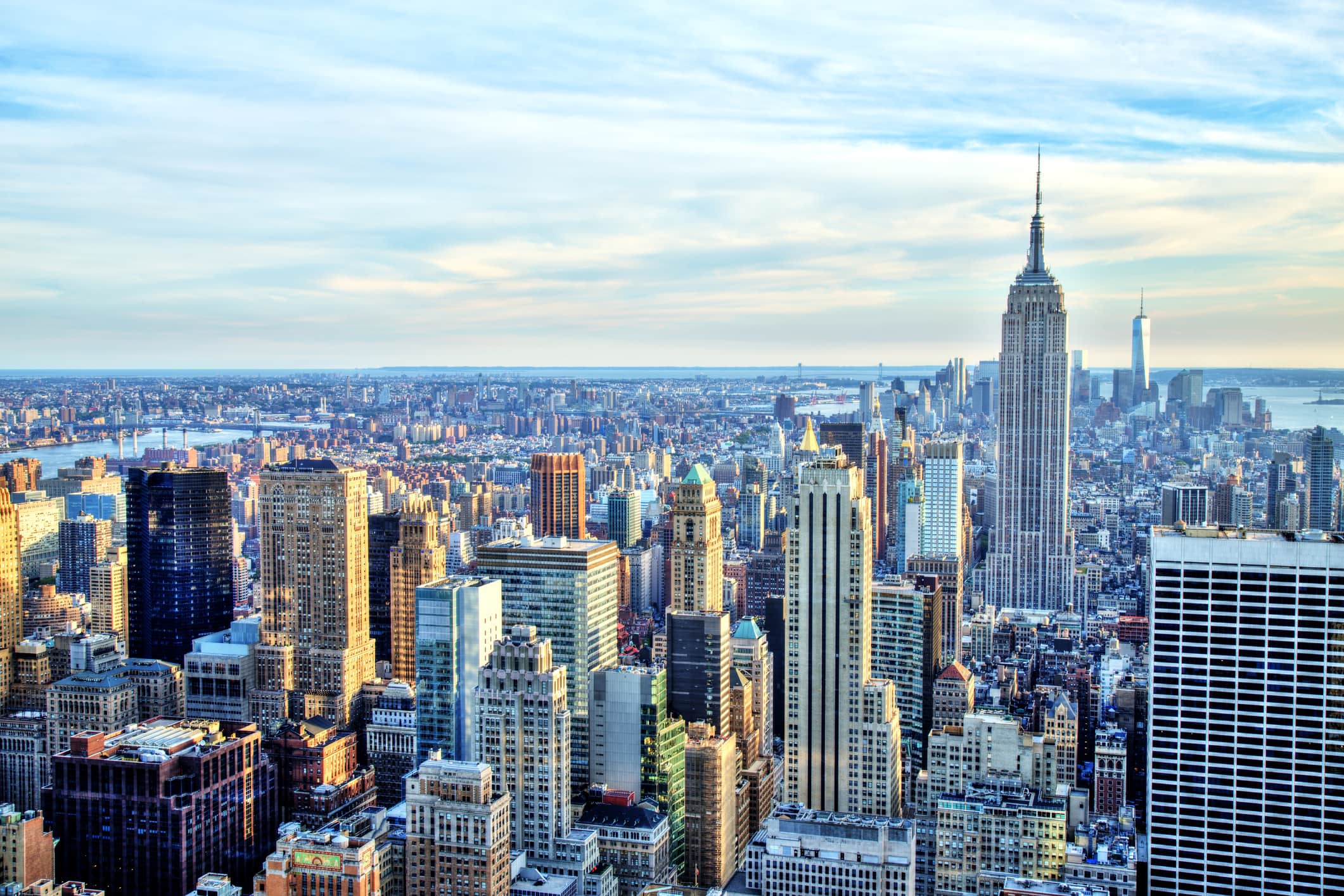Quick Facts about New York City
With more than 8 million residents in its five boroughs, New York City is the nation’s largest city and one of the most culturally diverse. Some arrive in pursuit of a career on Wall Street, while others want to build their own business from the ground up. Whether you’re a banker, an artist or a politician, the competition is biting in the Big Apple. But in this city, where the scale of your ambitions may be inverse to the size of your apartment, why not dream big? Where else would you rather be?
If you’re considering moving to New York state and NYC specifically, here is what you need to know about the Big Apple.
What’s It Like Living in New York City
Everyone has an opinion on what New York is like, but what does it really mean to be a New Yorker? Get a glimpse of your future in the Big Apple below, where we’ll uncover what makes this city the capital of American culture.
The Melting Pot of America
When it comes to culture, all roads meet in NYC. Despite recent outbound migration trends, New York City is far and away the most populous city in the country. The city alone is home to 8.3 million people, and the greater NYC area has nearly 24 million residents, a figure that dwarfs its nearest competitors, Los Angeles and Chicago.
New York is also one of the most ethnically and racially diverse cities in the world, with 31.9% of the population identifying as white, 28.9% as Hispanic/Latino, 23.4% as Black/African American, 14.2% as Asian/Asian American, 7.1% as two or more races, 0.5% as American Indian or Alaska Native and 0.1% as Native Hawaiian or other Pacific Islander. This cultural diversity has made New York an economic powerhouse and one of the most dynamic places on the planet. Its vast cultural offerings — the arts, the festivals and international cuisine — are unrivaled in the U.S. Learn more about New York’s best attractions below.
Four-Season Weather
As a northeastern city, New York is treated to four distinct seasons, with hot, steamy summers and sometimes frigid, snowy winters. But its coastal position helps moderate the worst extremes often felt by cities upstate, like Buffalo and Syracuse, where the snow falls by the foot and accumulates in small mountains on the sidewalks.
Over the course of the year, the 50 inches of rain New York City receives makes for a lush spring and a colorful fall. Central Park is most beautiful during these seasons, when flowering trees and falling leaves put on a show for all to enjoy.
In the wintertime, NYC receives around 30 inches of snow, and the city looks particularly beautiful dressed all in white. In the coldest months, temperatures range from single-digit lows to the upper 40s, with an average of 34 F.
Summertime is a different story. The average temp is a manageable 80 degrees, but expect highs in the 90s during the dog days of July and August. You’ll be in good company on a rooftop deck or on a blanket at Rockaway Beach.
Cost of Living is One of the Highest
What does it cost to live in a place this cool? Well, a lot, unfortunately. New York City is one of the most expensive places in the world to live, and housing, groceries and gas all cost more here than they do in the rest of the country, on average. The cost of housing in New York City is so high that only a third of residents own their own home in the city — that’s half the U.S. homeownership rate. Even San Francisco and Los Angeles have better homeownership rates than New York, despite having much higher housing costs. The median home value in NYC is $660,700 and rent in New York — which averages nearly $1,600/month — costs more than $400 more per month than the national average.
On top of these basic expenses, New York also has higher taxes than many states. Both personal income and sales taxes are elevated across the state. But, it’s worth noting that New York does have a graduated income tax rate, which theoretically alleviates some of the burden on lower-income brackets. Those making $8,500-$17,150 will pay 4.5%, while those making more than $25,000,000 pay 10.90%. If you’re bringing home what the average New Yorker does — $43,952 per capita/$70,663 per household — you’d be paying between 5.5% and 6%.
Please note: we are not tax experts and are not offering tax advice, other than you should consider obtaining additional information and advice from your legal and/or financial advisers who are fully aware of your individual circumstances.
Large and Competitive Job Market
So why do so many people want to live in New York City if it’s so expensive? One of the biggest reasons is the job market. Between Wall Street, big tech and the arts & entertainment industries, New York City has a greater variety of career paths than almost anywhere in the world. And, private sector jobs here are on the rise.
Since June 2022, New York City has gained 153,400 jobs, expanding the most in Private Education & Health Services, Leisure & Hospitality, Professional & Business Services, and Finance. New York City wages are also the highest in the state. The median wage for a private sector job in New York City is $116,738, but Finance & Insurance workers average $372,575 in earnings per year and tech gurus average $183,047 while Arts & Entertainment workers make $100,354 and those in Education earn only $90,067, on average. The unemployment rate in New York City is still far higher than the national and state level, rising to 5.9% in June 2023.
As the nation’s largest city, NYC generates $1.66 trillion in GMP, and the NYC region represents the largest consumer base in the nation. New York City is the global headquarters of Wall Street giants like Citi Group and JPMorgan Chase & Co., pharmaceutical colossi like Pfizer and entertainment megaliths like NBCUniversal. But it’s also home to thousands of mom-and-pops, hundreds of museums, galleries and theatres and dozens of colleges and universities — from renowned specialty schools like Pratt and Julliard to Ivy Leagues like Columbia University. It’s the combination of these institutions — large and small, public and private — that really makes New York City NYC.
Public Transportation and Bikes Are the Way to Get Around
When it comes to getting around, there isn’t much to love about driving in New York City. Car lanes are narrow and congested, gas is pricey, parking is impossible to find when you need it (and outrageously expensive all the time), and NYC drivers are, well, not so nice. So, why not ditch the car and save yourself and the planet a lot of unnecessary fuming?
New York City’s public transportation system is one of the most robust networks in the country, and New York City’s Metropolitan Transit Authority (MTA) manages more buses and commuter rail cars than all other cities combined. Although there’s certainly room for improvement in NYC’s public transportation, it’s still the most reliable way to get around.
New Yorkers also rely on ferries to avoid snarled traffic on the city’s many bridges and the long transit times to reach them. The NYC Ferry, the Staten Island Ferry (operated by NYC DOT) and other outfits get travelers quickly across the regional waterways. This ferry is essential for traveling between lower Manhattan and Brooklyn/Queens, both of which lie across the East River. The Staten Island Ferry is free and runs 24 hours a day.
If you are a confident two-wheel driver, biking across the city is still one of the fastest and greenest ways to get around in the five boroughs. You can beat driving commute times by using the network of bike lanes, and the Citi Bike bikeshare means you’ll never have to store your wheels in your apartment.
The Five Boroughs of New York City
Each of New York City’s five boroughs has a unique identity, and which one you choose to reside in will have a bearing on your cost of living, your commute time and even the kind of food you eat. Of course, within the neighborhoods of each borough, there are distinctive communities — expect a totally different scene in the West Village than on the Upper East Side of Manhattan, and these will be in stark contrast to Williamsburg in Brooklyn or Astoria in Queens. Here’s a quick take on the charms of Manhattan, the Bronx, Brooklyn, Queens and Staten Island.
Manhattan
The smallest by landmass but the largest in legend, Manhattan is the essence of NYC. This small sliver of land is home to Wall Street, Central Park, Broadway and the best bagels in the city. But on this tiny island, nearly 75,000 people per square mile somehow coexist — more than in any other county in America. All those eager-to-be New Yorkers have driven housing prices sky-high: the median home value in Manhattan is now over $1,000,000 and rents average nearly $1,900 per month.
The Bronx
Manhattan’s nearest neighbor, the Bronx is separated from New York County by only the narrow Harlem River. Without the South Bronx, the world would never have had Hip Hop, and without Belmont, America might never know the deliciousness of Borgatti’s beet fettuccine. The most affordable borough in New York City, the Bronx is still home to some of the city’s most desirable attractions: Yankee Stadium, the New York Botanical Garden and the Bronx Museum of the Arts.
Brooklyn
Quirky, eccentric and effortlessly cool, Brooklyn may have been born as a Dutch farmstead, but it’s grown into New York hippest borough. Brooklyn is small-business central, where specialty shops offer supplies for superheroes, robots play church music to human parishioners and bodegas are just a front for unexpected museums. Each of Brooklyn’s neighborhoods has its own unique flavor, from the elegant brownstones of Park Slope to the gallery-filled streets DUMBO (Down Under the Manhattan Bridge Overpass) that artists colonized in the 1990s.
Neighboring Queens is a blend of low-key vibes and high-life style with a heaping helping of big-city grit. You’ll find international enclaves of Greek, Bangladeshi and Latinx residents, where you can steep yourself in international food and culture. Historic Jamaica gave rise to some of the globe’s greatest jazz and rap artists, like John Coltrane and Run DMC. And some of the city’s most remarkable visual arts destinations are here: Socrates Sculpture Park, which showcases edgy, outdoor works, and the Noguchi Museum, which has a moving collection of renowned sculptor’s works. Both NYC airports are in Queens — LaGuardia is to the north and JFK is to the south — and it takes a good 45 minutes to get from one to the other…not that you’d ever mistakenly go to the wrong one, or anything.
Staten Island
Closer to New Jersey than Manhattan, New York City’s southernmost borough of Staten Island is also its least populous. Quiet streets with modest single-family homes and brick walk-ups are the norm in this close-knit district, and nearly 69% of residents own their own homes. In the Tompkinsville neighborhood, you’ll find some of the best Sri Lankan food in the U.S. — fish kottu, tender roti and curry, vegetable hoppers — which is no surprise, since Staten Island is home to the largest population of Sri Lankans outside the country itself. Staten Island beaches are popular summertime getaways for city-dwellers, attractions like the Snug Harbor Cultural Center & Botanical Gardens and the Staten Island Zoo will be fun diversions for everyone in your family.
Note: If you’re thinking of moving to New York City, it’s important to thoroughly research neighborhoods or areas in the city you might be interested in living in. Before you decide where you are going to reside, make sure you understand the area’s cost of living, commute time, tax rates, safety statistics and schooling information.
Numerous World-Famous Places and Events to Enjoy
With hundreds of landmarks, museums and international events, it’s just hard for other cities to compete with the cultural offerings of NYC. After all, there’s no more iconic skyscraper than the Empire State Building and there can be only one Statue of Liberty, despite some very convincing performance artists’ attempts. When you become a New Yorker, you’ll have access to some of the world’s most coveted art collections at the Guggenheim, MoMA, The Metropolitan Museum of Art and the Whitney. Not to mention the great seats you can snag to Broadway shows.
If you’ve already hit the highlights and are looking to really dig into your new hometown, the Brooklyn Children’s Museum — which first opened its doors in 1899 — is always a hit with the under 60” set. You’ll find hands-on exhibitions exploring art, nature, science and the city and be treated to kid-centric performances by hit musicians like Lady B.
A lot of human essentials were invented in NYC — air conditioning, toilet paper, Seinfeld — but nothing has dominated popular culture for the last 50 years like Hip Hop. For that, we have the Bronx to thank. In 2025, you’ll be able to immerse yourself in five decades of sweet beats at the Universal Hip Hop Museum, where you can learn about the artists and ordinary New Yorkers who gave rise to this musical revolution.
Back in Manhattan, puppy-lovers will sit, shake and roll over to get into the American Kennel Club Museum of the Dog, where everyone is a very good boy and human’s best friend is properly celebrated. Visitors can even see which dog breed looks most like them.
Though they may tire of the crowds, even seasoned New Yorkers can appreciate the city’s longstanding traditions — the Macy’s Thanksgiving Day Parade, the tree lighting in Rockefeller Center and even the ball drop at Times Square on New Year’s Eve. Some families have a custom of attending these every year, and others simply enjoy that this is a place that knows how to celebrate the season, with festive decorations and clever department store windows on avenues throughout the city.
In addition to these holiday fêtes, the Big Apple also hosts events like New York Fashion Week (NYFW), which makes all of NYC its runway. The annual Orchid Show gathers the world’s most alluring epiphytes in one climate-controlled, colorful conservatory at the New York Botanical Garden. And, for 121 years, the New York International Auto Show has drawn gearheads from around the globe to honor the “horseless carriage,” with an indoor EV test track and the outdoor obstacle course of the thrilling Camp Jeep.
Get Outdoors in New York
When you think of New York City, nature may not be the first thing that comes to mind, but the Big Apple is more than a concrete jungle. Sprawling greenspaces, sandy beaches and tiny pocket parks give NYC residents a respite from the gravel and the grind of daily life. Here are a few recommendations for outdoor relief.
Central Park is one of the city’s most famous and beloved treasures. It’s the destination for daily joggers, who can run for miles on car-free trails. Birders know that this is one of the best spots to spy a saw-whet owl, a cedar waxwing or a yellow warbler. And chess-players, jazz enthusiasts and funkaerobicists know they’ll find their kin at free events throughout the year. The park is enormous, though, so the best way to get your bearings is on a tour. The park offers free audio guides of different park regions and there’s also a paid, in-person tour of the park’s iconic spots.
If you live in the Bronx, you’ll have a thousand green acres to relax in at Van Cortlandt Park, where wooded trails pave the way for urban hikers, bikers and equestrians. Athletes can face off in every imaginable sport, from cricket to bocce to golf, and the skate park is a favorite of shredders in this northwestern borough. In the summertime, you’ll find all your friends at the park’s pool during the day and enjoying free movie screenings at night.
It may surprise you to learn that neither of these parks is actually the city’s largest. That distinction goes to the 2,764-acre Pelham Bay Park in the northeastern Bronx. This waterside gem has cooling beaches along the Long Island Sound, bridle paths, nature centers and several playgrounds, one specifically designed with sensory elements for children on the Autism spectrum to enjoy.
If you want to feel like you’ve escaped the city for a day without really ever leaving, take the ferry out to Governor’s Island, where cars are not allowed. Absent the typical NYC traffic, you are free to hear your own thoughts or, if even that is too much, give your brain the day off while you bike and zipline your troubles away.
New Yorkers Take Sports Seriously
As a new New Yorker, you may run out of patience, time or money, but one thing you will never be short of in the city i professional sports. Whether you’re a fan of the Mets, the Jets or the Nets, there is always a team playing something somewhere, with someone rooting hard for and against them. The Bronx leans into their little neighborhood team — maybe you’ve heard of them? — the NY Yankees, while the New York Knicks and the New York Rangers alternately heat up and put the freeze on Madison Square Garden.
If you’re not into the NFL, MLB, NBA/WNBA, NHL or MLS/NWSL, NYC is still a place to get your game on. The city plays host to tennis stars at the U.S. Open each summer and the largest gathering of long-distance runners in the world at the New York City Marathon each fall.
Many Cuisine Adventures Await
It’s hard to think of New York City without envisioning a perfect slice of Joe’s pizza, a steaming salted pretzel or a bagel from Zabar’s with a heavy schmear of lox spread, but the 8.3 million residents here survive on more than carbohydrates and cheese. Not that you have to or anything, but if you want to alternate with Nathan’s hot dogs and Katz’ hot pastrami or kimchi and kebabs, you can. Here are a few NYC restaurants that will grab you by your taste buds.
A mere block from the Empire State Building, HanGawi prepares humble-delicious plant-based Korean fare in the heart of Midtown — black truffle dumplings, kochi skewers and spicy grilled kodok all aim to please.
Down the street from MOMA PS1 in Queens, r40 brings the soul of Argentina to Long Island City. Begin with the Clams Patagonia, which perfectly combine the flavors of the Americas — North and South — and then get an empanada basket for the table so that you don’t have to choose between the Al Cuchillo (with filet mignon) and the Crab & Shrimp. The Parrillada for Two — which comes with short ribs, blood sausage, sweetbreads and more — is a serious meat commitment, but carnivores won’t regret it a bit. Whatever you order, be sure to save room for their chocolate olive oil cake.
In Brooklyn, you’ll find authentic Nigerian food impeccably prepared at Buka. The traditional cuisine at this Clinton Hill establishment hasn’t been modified to suit unadventurous palates, but you’ll quickly adjust to the delights of the unfamiliar. The suya-spiced shrimp are a good way to dip your toe into these exciting, new waters, but then you can move on to the Isiewu (goat head cooked in traditional Igbo spices) and the Igbin (large land snails). Of course, everyone loves the Pof Pof — little doughnuts with a hint of nutmeg and other spices.
Prepare for Your Move to the Big Apple
Ready to move? Get a moving quote for New York City.
By choosing a professional, long-distance mover like United Van Lines, you can make moving to the Big Apple a seamless experience. We can help you relocate to NYC from anywhere outside New York State
We offer customized, full-service moving packages for cross-country moves to New York City, which can include car shipping, packing and unpacking, debris removal, storage services and more. The MyUnited Move Portal will keep track of all the details of your move.
If you’re moving within New York, we can assist you with local moves/movers in New York City and the state of New York. United Van Lines’ interstate New York agents can provide local moving services to help you move within the Empire State independently under their own businesses and brands.
Would you prefer to handle your own move to New York? United Van Lines has a wealth of moving resources for those who want to take a DIY approach, and we offer helpful tips on making a moving checklist, packing your home and things to see and do in the New York region.
If you’re unsure where you’ll be moving to the New York area, United Van Line’s Guide to Moving to New York State offers helpful information about the most popular cities in New York.





